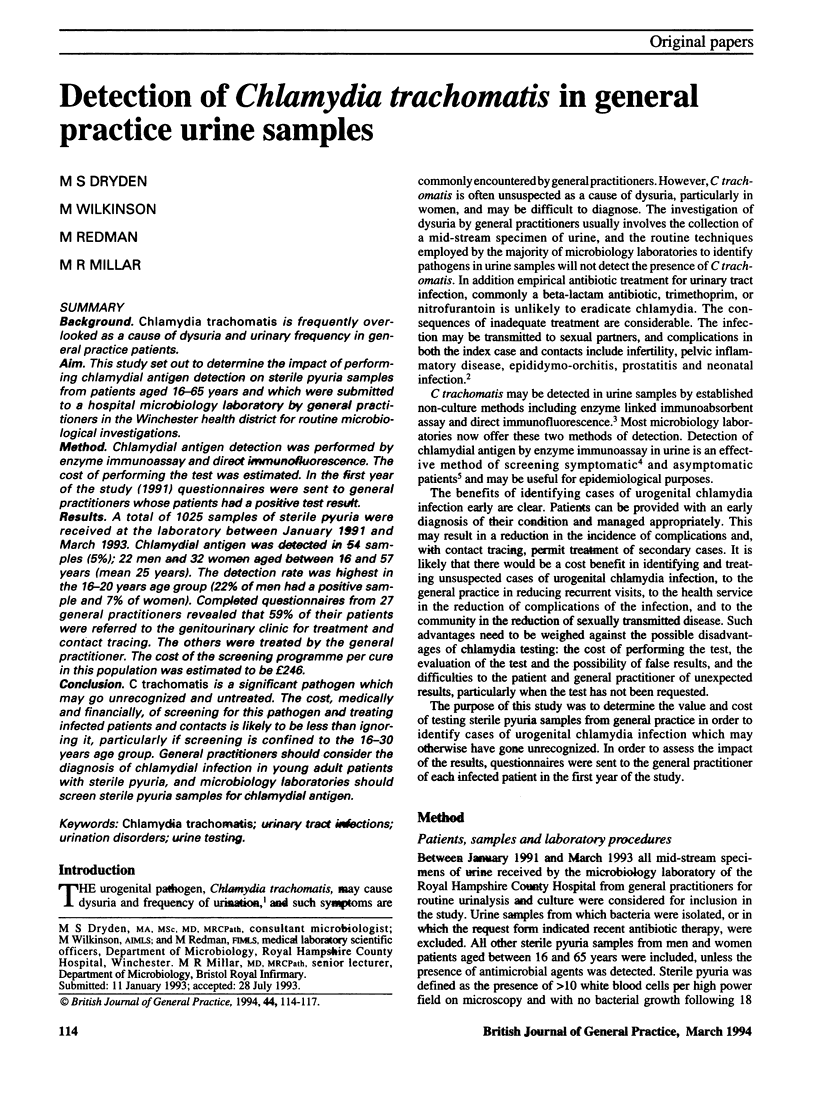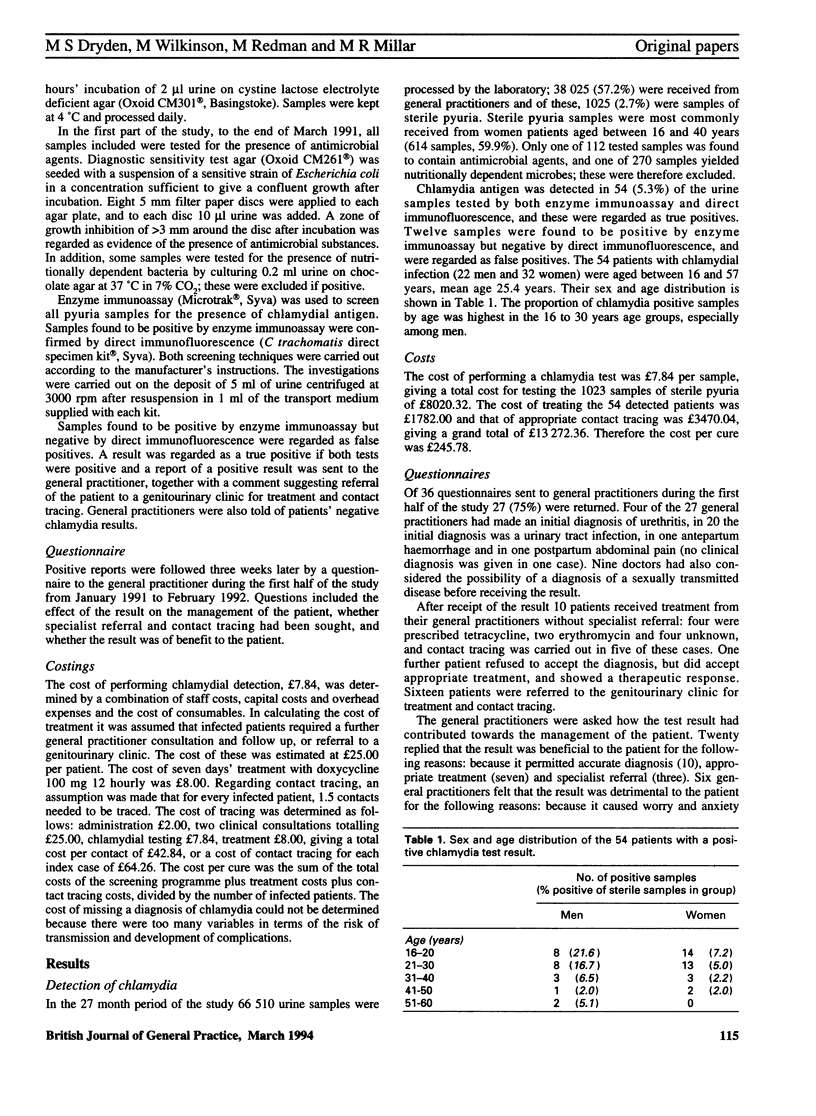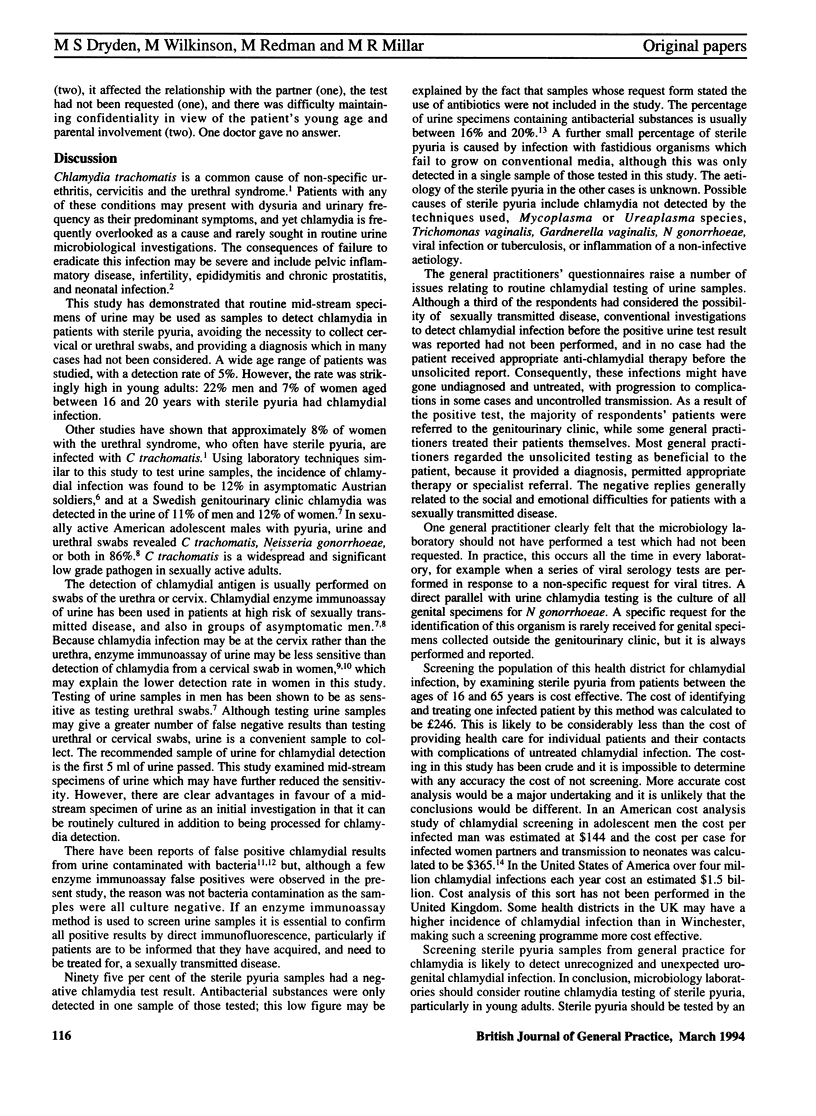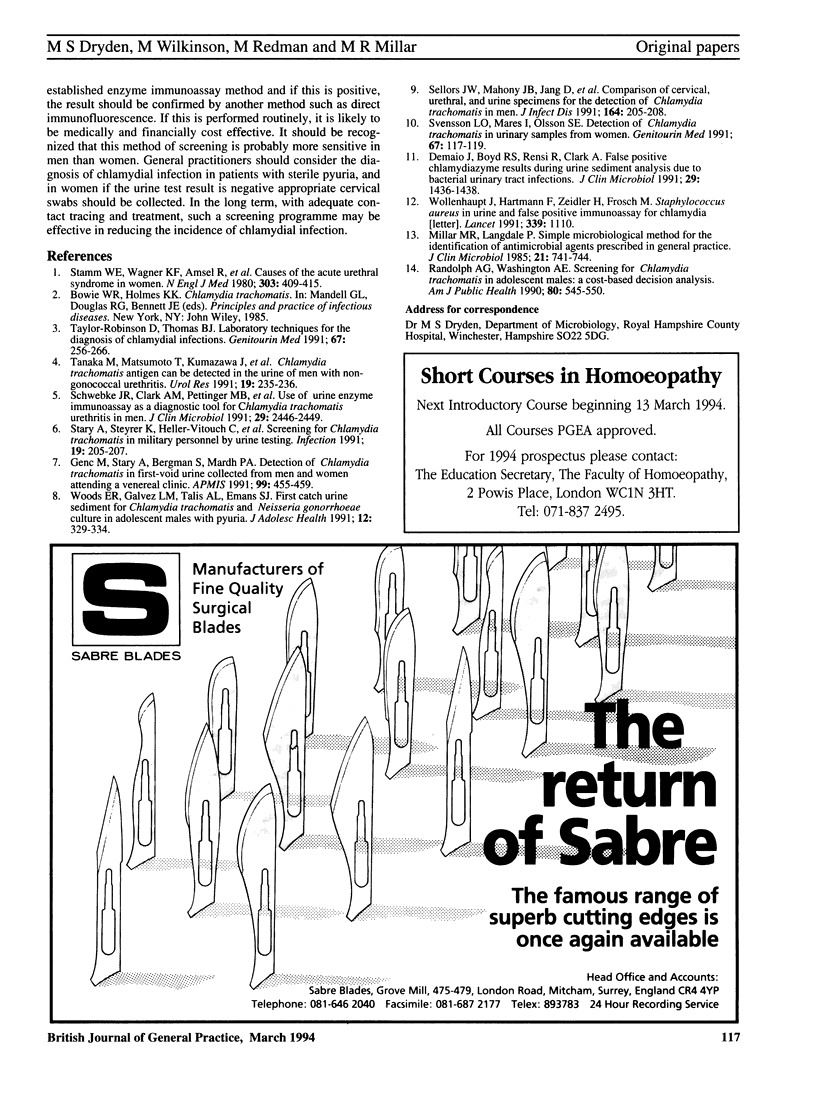Abstract
BACKGROUND. Chlamydia trachomatis is frequently overlooked as a cause of dysuria and urinary frequency in general practice patients. AIM. This study set out to determine the impact of performing chlamydial antigen detection on sterile pyuria samples from patients aged 16-65 years and which were submitted to a hospital microbiology laboratory by general practitioners in the Winchester health district for routine microbiological investigations. METHOD. Chlamydial antigen detection was performed by enzyme immunoassay and direct immunofluorescence. The cost of performing the test was estimated. In the first year of the study (1991) questionnaires were sent to general practitioners whose patients had a positive test result. RESULTS. A total of 1025 samples of sterile pyuria were received at the laboratory between January 1991 and March 1993. Chlamydial antigen was detected in 54 samples (5%); 22 men and 32 women aged between 16 and 57 years (mean 25 years). The detection rate was highest in the 16-20 years age group (22% of men had a positive sample and 7% of women). Completed questionnaires from 27 general practitioners revealed that 59% of their patients were referred to the genitourinary clinic for treatment and contact tracing. The others were treated by the general practitioner. The cost of the screening programme per cure in this population was estimated to be 246 pounds. CONCLUSION. C trachomatis is a significant pathogen which may go unrecognized and untreated. The cost, medically and financially, of screening for this pathogen and treating infected patients and contacts is likely to be less than ignoring it, particularly if screening is confined to the 16-30 years age group. General practitioners should consider the diagnosis of chlamydial infection in young adult patients with sterile pyuria, and microbiology laboratories should screen sterile pyuria samples for chlamydial antigen.
Full text
PDF



Selected References
These references are in PubMed. This may not be the complete list of references from this article.
- Demaio J., Boyd R. S., Rensi R., Clark A. False-positive Chlamydiazyme results during urine sediment analysis due to bacterial urinary tract infections. J Clin Microbiol. 1991 Jul;29(7):1436–1438. doi: 10.1128/jcm.29.7.1436-1438.1991. [DOI] [PMC free article] [PubMed] [Google Scholar]
- Genç M., Stary A., Bergman S., Mårdh P. A. Detection of Chlamydia trachomatis in first-void urine collected from men and women attending a venereal clinic. APMIS. 1991 May;99(5):455–459. [PubMed] [Google Scholar]
- Millar M. R., Langdale P. Simple microbiological method for the identification of antimicrobial agents prescribed in general practice. J Clin Microbiol. 1985 May;21(5):741–744. doi: 10.1128/jcm.21.5.741-744.1985. [DOI] [PMC free article] [PubMed] [Google Scholar]
- Randolph A. G., Washington A. E. Screening for Chlamydia trachomatis in adolescent males: a cost-based decision analysis. Am J Public Health. 1990 May;80(5):545–550. doi: 10.2105/ajph.80.5.545. [DOI] [PMC free article] [PubMed] [Google Scholar]
- Schwebke J. R., Clark A. M., Pettinger M. B., Nsubga P., Stamm W. E. Use of a urine enzyme immunoassay as a diagnostic tool for Chlamydia trachomatis urethritis in men. J Clin Microbiol. 1991 Nov;29(11):2446–2449. doi: 10.1128/jcm.29.11.2446-2449.1991. [DOI] [PMC free article] [PubMed] [Google Scholar]
- Sellors J. W., Mahony J. B., Jang D., Pickard L., Goldsmith C. H., Gafni A., Chernesky M. A. Comparison of cervical, urethral, and urine specimens for the detection of Chlamydia trachomatis in women. J Infect Dis. 1991 Jul;164(1):205–208. doi: 10.1093/infdis/164.1.205. [DOI] [PubMed] [Google Scholar]
- Stamm W. E., Wagner K. F., Amsel R., Alexander E. R., Turck M., Counts G. W., Holmes K. K. Causes of the acute urethral syndrome in women. N Engl J Med. 1980 Aug 21;303(8):409–415. doi: 10.1056/NEJM198008213030801. [DOI] [PubMed] [Google Scholar]
- Stary A., Steyrer K., Heller-Vitouch C., Müller I., Mårdh P. A. Screening for Chlamydia trachomatis in military personnel by urine testing. Infection. 1991 Jul-Aug;19(4):205–207. doi: 10.1007/BF01644946. [DOI] [PubMed] [Google Scholar]
- Svensson L. O., Mares I., Olsson S. E. Detection of Chlamydia trachomatis in urinary samples from women. Genitourin Med. 1991 Apr;67(2):117–119. doi: 10.1136/sti.67.2.117. [DOI] [PMC free article] [PubMed] [Google Scholar]
- Tanaka M., Matsumoto T., Kumazawa J., Nakayama H., Miyazaki Y. Chlamydia trachomatis antigen can be detected in the urine sample of men with non-gonococcal urethritis. Urol Res. 1991;19(4):235–236. doi: 10.1007/BF00305301. [DOI] [PubMed] [Google Scholar]
- Taylor-Robinson D., Thomas B. J. Laboratory techniques for the diagnosis of chlamydial infections. Genitourin Med. 1991 Jun;67(3):256–266. doi: 10.1136/sti.67.3.256. [DOI] [PMC free article] [PubMed] [Google Scholar]
- Woods E. R., Galvez L. M., Talis A. L., Emans S. J. First catch urine sediment for Chlamydia trachomatis and Neisseria gonorrhoeae culture in adolescent males with pyuria. J Adolesc Health. 1991 Jun;12(4):329–334. doi: 10.1016/0197-0070(91)90009-b. [DOI] [PubMed] [Google Scholar]


